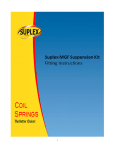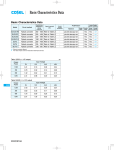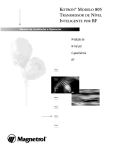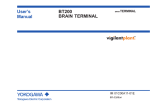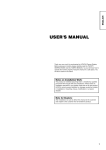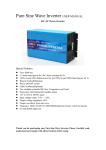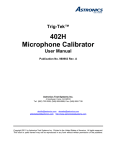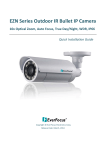Download Basic characteristics data • Instruction manual
Transcript
Basic Characteristics Data Basic Characteristics Data Model MG15 Circuit method Flyback converter Switching frequency [kHz] (reference) Input current [A] Inrush current protection Material 445-495 *1 - Series/Parallel operation PCB/Pattern Single sided Double sided Series operation Parallel operation glass fabric base,epoxy resin Yes Yes *2 MGF15 Flyback converter 445-495 *1 - glass fabric base,epoxy resin Yes Yes *2 MG30 Forward converter 380-460 *1 - glass fabric base,epoxy resin Yes Yes *2 MGF30 Forward converter 380-460 *1 - glass fabric base,epoxy resin Yes Yes *2 *1 Refer to Specification. *2 Refer to the Instruction Manual. MG MG-18 DC-DC Converters PCB Mount Type Instruction Manual 1 Pin Configuration MG-20 2 Functions MG-20 3 4 2.1 Input Voltage Range MG-20 2.2 Overcurrent Protection MG-20 2.3 Overvoltage Protection MG-20 2.4 Isolation MG-21 2.5 Output Voltage Adjustment Range MG-21 2.6 Remote ON/OFF MG-21 12 MG-27 Lifetime expectancy depends on MG-27 stress by temperature difference 12.1 MG15/MGF15 Lifetime expectancy depends on stress by temperature difference 12.2 MG-27 MG30/MGF30 Lifetime expectancy depends on stress by temperature difference MG-27 Wiring to Input/Output Pin MG-21 3.1 Wiring input pin MG-21 3.2 Wiring output pin MG-22 Series/Parallel Operation MG-22 4.1 Series Operation MG-22 4.2 Redundancy Operation MG-23 5 Input Voltage/Current Range MG-23 6 Assembling and Installation MG-23 6.1 Installation MG-23 6.2 Hand Mounting MG-23 6.3 Soldering Conditions MG-23 6.4 Stress to Pin MG-23 6.5 Cleaning MG-23 7 Safety Standards MG-24 8 Derating MG-24 9 11 Note to use ±5V output 8.1 MG15/MGF15 Derating Curve MG-24 8.2 MG30/MGF30 Derating Curve MG-24 Peak Current (Pulse Load) MG-25 10 Using DC-DC Converters MG-26 MG-19 MG Instruction Manual DC-DC Converters PCB Mount Type ¿Single Output 1 Pin Configuration <View from Above> <Top view> 3 Table 1.1 Pin Configuration and Functions (MG15) Pin No. 1 2 3 4 5 6 Pin Name +Vin -Vin RC +Vout TRM COM -Vout Function Input +DC Input -DC Input Remote ON/OFF +DC Output Output Voltage Adjustment (please see 2.5) GND of Output Voltage (for Dual Output) -DC Output 2 -Vin -Vout 1 +Vin +Vout Input 2 1 Input <View from Above> <Top view> RC 2 -Vin 1 +Vin -Vout TRM +Vout Input 2 1 4 -Vout 6 RC -Vin +Vin Load COM Load 5 Load +Vout 4 6 Fig.1.2 Pin Configuration (MG30) 5 Load 4 2 Functions ¿Dual(±)Output 3 5 Load <Top <View fromview> Above> MG 3 6 ¿Dual(±)Output 3 ¿Single Output TRM RC 2.1 Input Voltage Range <Top view> <View from Above> RC -Vout ¡If output voltage value doesn’t fall within specifications, a unit may not operate in accordance with specifications and/or fail. 6 Load -Vin COM Load 5 +Vin Load +Vout 4 Fig.1.1 Pin Configuration (MG15) 2.2 Overcurrent Protection ¡Overcurrent Operation An overcurrent protection circuit is built-in and activated at 105% of the rated current or above. It prevents the unit from short circuit and overcurrent for less than 20 seconds. The output voltage of the power supply will recover automatically if the fault causing over current is corrected. Table 1.2 Pin Configuration and Functions (MG30) Pin No. 1 2 3 4 5 6 Pin Name +Vin -Vin RC +Vout -Vout COM TRM -Vout Function +DC Input -DC Input Remote ON/OFF +DC Output -DC Output (for Single Output) GND of Output Voltage (for Dual Output) Output Voltage Adjustment (please see 2.5) -DC Output (for Dual Output) When the output voltage drops after OCP works, the power supply enters a “hiccup mode” where it repeatedly turns on and off at a certain frequency. 2.3 Overvoltage Protection (Excluding MG15) ¡Over Voltage Protection (OVP) is built in. When OVP works, output voltage can be recovered by shutting down DC input for at least one second or by turning off the remote control switch for one second without shutting down the DC input. The recovery time varies according to input voltage and input capacitance. Remarks : Note that devices inside the power supply may fail when a voltage greater than the rated output voltage is applied from an external power supply to the output terminal of the power supply. This could happen in in-coming inspections that include OVP function test or when voltage is applied from the load circuit. MG-20 Instruction Manual DC-DC Converters PCB Mount Type 2.4 Isolation 2.6 Remote ON/OFF ¡When you run a Hi-Pot test as receiving inspection, gradually increase the voltage to start. When you shut down, decrease the ¡The remote ON/OFF function is incorporated in the input circuit and operated with RC and -Vin. If positive logic control is re- voltage gradually by using a dial. Please avoid a Hi-Pot tester with quired, order the power supply with “-R” option. a timer because, when the timer is turned ON or OFF, it may genTable 2.2 Remote ON/OFF Specifications erate a voltage a few times higher than the applied voltage. ON/OFF logic 2.5 Output Voltage Adjustment Range(MGS/MGFS Only) ¡The output voltage is adjustable through an external potentiometer. Adjust only within the range of ±10% of the rated voltage. ¡To increase the output voltage, turn the potentiometer clockwise and connect in such a way that the resistance value between 2 and 3 becomes small. To decrease the output voltage, turn the potentiometer counter- Standard Optional -R Negative Positive Between RC and -Vin Output voltage L level (0 - 1.2V) or short H level (3 - 12V) or open L level (0 - 1.2V) or short H level (3 - 12V) or open ON OFF OFF ON ¡When RC is at low level, a current of 0.5mA typ will flow out. ¡When remote ON/OFF is not used, short RC and -Vin. clockwise. ¡Please use a wire as short as possible to connect to the potentiometer and connect it from the pin on the power supply side. TemVcc perature coefficient deteriorates when some types of resistors and potentiometers are used. Please use the following types. Resistor............ Metal Film Type, Temperature Coefficient of RC RC t100ppm/C or below Potentiometer... Cermet Type, Temperature Coefficient of Transistor Opto coupler ¡If output voltage adjustment is not required, open the TRM pin. ¡Output voltage adjustment may increase to overvoltage protection activation range based on determined external resister values. -Vin -Vin t300ppm/C or below RC RC -Vin -Vin IC 1 Output +Vout External Resistor R1 TRM -Vout 2 External Resistor R2 3 Table 2.1 List of External Devices Constant of External Device [W] 1 2 3 4 5 6 7 3.3V 5V 12V 15V ±5V ±12V ±15V Fig.2.2 RC Connection Example External VR Load Fig.2.1 Connecting External Devices Item # Output Voltage Relay (Adjustable within ±10%) VR R1 R2 1k 100 100 1k 100 270 5k 10k 1.5k 5k 10k 1k 3 Wiring to Input/Output Pin 3.1 Wiring input pin ¡MG series has Pi-shaped filter internally. You can add a capacitor Ci near the input pin termilal and reduce reflected input noise from the converter. Please connect the capacitor as needed. ¡When you use a capacitor Ci, please use the one with high frequency and good temperature characteristics. ¡If the power supply is to be turned ON/OFF directly with a switch, inductance from the input line will induce a surge voltage several times that of the input voltage and it may damage the power supply. Make sure that the surge is absorbed, for example, by connecting an electrolytic capacitor between the input pins. MG-21 MG Instruction Manual DC-DC Converters PCB Mount Type ¡If an external filter containing L (inductance) is added to the input line or a wire from the input source to the MG series is long, not only the reflected input noise becomes large, but also the output of the converter may become unstable. In such case, connecting Ci to the input pin is recommended. ¡If you use an aluminum electrolytic capacitor, please pay attention to the ripple current rating. L Input +Vin Ci Table 3.2 Recommended Capacitance of External Capacitor on the Output Side [ F] Model Output Voltage[V] 3.3 5 12 15 ±5 ±12 ±15 MG15 MG30 470 470 150 100 330 100 47 470 470 150 100 330 100 47 *If you use a ceramic capacitor, keep the capacitance within the rage between about 0.1 to 22 F. -Vin *Please adjust the capacitance in light of the effect you want to achieve. MG Fig.3.1 Connecting an External Capacitor to the Input Side Table 3.1 Recommended Capacitance of an External Capacitor on the Input Side [ F] Model Input Voltage[V] 12 24 48 12 - 24 24 - 48 MG15 MG30 220 100 47 100 47 220 100 47 100 47 *If you need to use an unproven external capacitor which capacitance moreover the range provided in Table 3.2, please contact us for the assistance. ¡If the distance between the output and the load is long and therefore the noise is generated on the load side, connect a capacitor externally to the load as shown below. *Please adjust the capacitance in accordance with a degree of the effect you want to achieve. +Vin +Vout -Vin -Vout Load Input ¡If a reverse polarity voltage is applied to the input pin, the power supply will fail. Fig.3.4 Connecting Example If there is a possibility that a reverse polarity voltage is applied, connect a protection circuit externally as described below. Fuse Input 4 Series/Parallel Operation +Vin Schottky Barrier Diode -Vin Fig.3.2 Connecting a Reverse Voltage Protection Circuit 4.1 Series Operation ¡You can use the power supplies in series operation by wiring as shown below. In the case of (a) below, the output current should 3.2 Wiring output pin be lower than the rated current for each power supply with the ¡If you want to further reduce the output ripple noise, connect an electrolytic capacitor or a ceramic capacitor Co to the output pin lowest rated current among power supplies that are serially connected. Please make sure that no current exceeding the rated current flows into a power supply. as shown below. (a) +Vout Co -Vout Load Co Load Co Load + - COM -Vout MGS/MGFS MGW/MGFW Fig.3.3 Connecting Example of an External Capacitor to the Output Side MG-22 Power Supply Load +Vout Power + Supply - Instruction Manual DC-DC Converters PCB Mount Type + 6 Assembling and Installation Load Power Supply - 6.1 Installation Load (b) Power + Supply - ¡When two or more power supplies are used side by side, position them with proper intervals to allow enough air ventilation. Ambient temperature around each power supply should not exceed the Fig.4.1 Series Operation temperature range shown in derating curve. 4.2 Redundancy Operation 6.2 Hand Mounting ¡You can use the power supplies in redundancy operation by wiring as shown below. I1 I3 + 6.3 Soldering Conditions Load Power Supply I2 Power Supply ¡Due to prevent failure, PS should not be pull after soldering with PCB. + (1) Flow Soldering : 260C 15 seconds or less (2) Soldering Iron : maximum 360C 5 seconds or less - Fig.4.2 Redundancy Operation ¡Even a slight difference in output voltage can affect the balance between the values of I1 and I2. Please make sure that the value of I3 does not exceed the rated current for each power supply. I3 [ Rated Current Value 6.4 Stress to Pin ¡Applying excessive stress to the input or output pins of the power module may damage internal connections. Avoid applying stress in excess of that shown in Fig. 6.1. ¡Input/output pin are soldered to the PCB internally. Do not pull or bend a lead powerfully. ¡If it is expected that stress is applied to the input/output pin due to vibration or impact, reduce the stress to the pin by taking such measures as fixing the unit to the PCB by silicone rubber, etc. 5 Input Voltage/ Current Range ¡If you use a non-regulated power source for input, please check and make sure that its voltage fluctuation range and ripple voltage do not exceed the input voltage range shown in specifications. 19.6N (2kgf) or less ¡Please select an input power source with enough capacity, taking into consideration of the start-up current (Ip), which flows when a DC-DC converter starts up. 19.6N (2kgf) or less Fig.6.1 Stress onto Pins Input Current [A] Input Voltage Range Ip 6.5 Cleaning ¡If you need to clean the unit, please clean it under the following conditions. Cleaning Method: Varnishing, Ultrasonic or Vapor Cleaning Cleaning agent: IPA (Solvent type) Cleaning Time: Within total 2 minutes for varnishing, ultrasonic and vapor cleaning Input Voltage [V] Fig.5.1 Input Current Characteristics ¡Please dry the unit sufficiently after cleaning. ¡If you do ultrasonic cleaning, please keep the ultrasonic output at 15W/ or below. MG-23 MG DC-DC Converters PCB Mount Type Instruction Manual (3) In the case of Forced Air Cooling (1.0m/s, 2.5m/s)(MGW15O05/ 7 Safety Standards MGFW15O05) tails. ¿Please use the unit as a component of an end device. ¿The area between the input and the output of the unit is isolated Load factor [%] 100 ¡To apply for a safety standard approval using the power supply, please meet the following conditions. Please contact us for de- 1 Forced air 1 1.0 m/s 2 2.5 m/s 50 2 functionally. Depending upon the input voltage, basic insulation, dual insulation or enhanced insulation may be needed. In such 0 - 40 case, please take care of it within the structure of your end-device. - 20 0 20 40 60 80 (85) 100 Ambient temperature Ta [C] Please contact us for details. Fig.8.3 Derating Curve for Forced Air Cooling (1.0m/s,2.5m/s) (Rated Input Voltage) MG (4) Temperature Measuring Point on the case. 8 Derating ¡In case of forced air cooling, please have sufficient ventilation to keep the temperature of point A in Fig.8.4 at 105C or below. Please also make sure that the ambient temperature does not ex- 8.1 MG15 / MGF15 Derating Curve ceed 85C. Point A (Center of the Case) ¡If you derate the output current, you can use the unit in the temperature range from -40C to the maximum temperature shown below. (1) In the case of Convection Cooling Load factor [%] 100 Natural Convection 1 MGW15O05 / MGFW15O05 2 others 50 0 - 40 Fig.8.4 Temperature Measuring Point on the case (Top View) 2 1 8.2 MG30 / MGF30 Derating Curve ¡If you derate the output current, you can use the unit in the temperature range from -40C to the maximum temperature shown below. - 20 0 20 40 (55) 60 80 (85) 100 (1) In the case of Convection Cooling Ambient temperature Ta [C] 100 (2) In the case of Forced Air Cooling (1.0m/s)(Excluding MGW15O05/MGFW15O05) Load factor [%] 100 Load factor [%] Fig.8.1 Derating Curve for Convection Cooling (Rated Input Voltage) 3 2 1 Natural Convection 1 MGFS302412 MGFW302415 / 4815 2 MGFS302415 / 4812 / 4815 3 others 50 Forced air (1.0m/s) 0 - 40 50 - 20 0 20 40 (55) 60 80 (85) 100 Ambient temperature Ta [C] Fig.8.5 Derating Curve for Convection Cooling (Rated Input Voltage) 0 - 40 - 20 0 20 40 60 80 (85) 100 Ambient temperature Ta [C] Fig.8.2 Derating Curve for Forced Air Cooling (1.0m/s) (Rated Input Voltage) MG-24 DC-DC Converters PCB Mount Type (2) In the case of Forced Air Cooling (1.0m/s)(Excluding MGW30O05 and MGFW30O12/15) Load factor [%] 100 Forced air (1.0m/s) Instruction Manual 9 Peak Current (Pulse Load) ¡If a load connected to a converter is a pulse load, you can provide a pulse current by connecting an electrolytic capacitor externally 50 to the output side. Iop +Vin 0 - 40 - 20 0 20 40 60 80 (85) +Vout C 100 COM Pulse Load Vo Ambient temperature Ta [C] -Vin -Vout Fig.8.6 Derating Curve for Forced Air Cooling (1.0m/s) (Rated Input Voltage) External Electrolytic Capacitor (3) In the case of Forced Air Cooling (1.0m/s, 1.5m/s)(MGW30O05 Iop and MGFW30O12/15) Iop:Current at Peak Is :Steady-state Current Load factor [%] 100 1 Forced air 1 1.0 m/s 2 1.5 m/s 50 2 Waveform of Pulse Load Current Is 0 DVo Waveform of Output Voltage 0 - 40 - 20 0 20 40 60 80 (85) 100 Ambient temperature Ta [C] Fig.8.7 Derating Curve for Forced Air Cooling (1.0m/s,1.5m/s) (Rated Input Voltage) (4) Temperature Measuring Point on the case. ¡In case of forced air cooling, please have sufficient ventilation to keep the temperature of point A in Fig.8.8 at 110C or below. Please also make sure that the ambient temperature does not exceed 85C. Point A (Center of the Case) 0 DVo:Fluctuation of Output Voltage t T ¡The average output current lav is expressed in the following formula. (Iop - Is)Xt lav = ls+ T ¡Required electrolytic capacitor C can be obtained from the following formula. (Iop - Iav)Xt C= DVo Fig.8.8 Temperature Measuring Point on the case (Top View) MG-25 MG DC-DC Converters PCB Mount Type Instruction Manual *Output current should be the same as the rated output current of the converter. 10 Using DC-DC Converters *Output current fluctuation is the sum of the input voltage fluctuation and the output voltage fluctuation of the converter. ¡To use a dual output type *Dual output type is typically used in the following manner. ¡When using AC power source +Vin +Vout -Vin -Vout +Vin +15V 0 COM -15V -Vin MG ¡When using a battery-operated device +Vin +Vout COM -Vin -Vout +12V COM 0 -Vout -12V Example MGW152412 *The unit can be used as a 24V type single output power supply as follows. +15V 0 +24V -15V +Vin ¡When a floating mechanism is required for the output circuit +Vin +Vout +Vout COM -Vin +Vout -Vout 0 Example MGW152412 Load -Vin -Vout Floating from the GND level *Another way to use the unit is described below. *The sum of +12V and +24V flows to the 0V line. Please make sure that this value does not exceed the rated output current of the converter. ¡To draw a reverse polarity output +Vin +Vin 12V -Vin -Vin -Vout -Vin COM +12V -Vout 0 Example MGW152412 ¡To provide a negative voltage to -Vin by using +Vin side of the converter as GND potential (0V) -48V +24V -12V Example MGS151212 +Vin +Vout +Vout +Vout -Vout ¡To draw 48V output +Vin +Vout +48V COM +5V -Vin -Vout +Vin +Vout 0 COM Example MGS154805 -Vin ¡To draw the sum of input voltage and plus output voltage +Vin +Vout +27V -Vin -Vout 0 12V Example MGS151215 MG-26 -Vout Example MGW152412 0 DC-DC Converters PCB Mount Type Instruction Manual Point A (Center of the Case) 11 Note to use ±5V output +Vin +Vout R LOAD 100% R LOAD 0-5% COM -Vin -Vout Fig.12.2 Temperature measuring point (Top View) ¡The warranty period is basically 10 years, however it depends on the lifetime expectancy which is shown in Fig.12.1 if it is less than Fig.11.1 Example of decreasing the fluctuation of output voltage. ¡If an output current is 0% to 5% of the rated current, the output is influenced by the other output load condition. 20% output voltage fluctuation may occer. To avoid the fluctuation, external bleeding resister is required to draw sufficient current. 10 years. MG 12.2 MG30 / MGF30 Lifetime expectancy depends on stress by temperature difference ¡Product lifetime expectancy depends on case temperature difference ( Tc) and number of cycling in a day is shown in Fig.12.3 (It is calculated based on our accelerated process test result.) 12 Lifetime expectancy depends on stress by temperature difference If case temperature changes frequently by changing output load factor etc., the above the lifetime expectancy design should be applied as well. And point A which is shown in Fig.12.4 must keep ¡Regarding lifetime expectancy design of solder joint, following contents must be considered. It must be careful that the soldering joint is stressed by temperature rise and down which is occurred by self-heating and ambient temperature change. The stress is accelerated by thermal-cycling, therefore the temperature difference should be minimized as much as possible if temperature rise and down is occurred frequently. 12.1 MG15 / MGF15 Lifetime expectancy depends on stress by temperature difference ¡Product lifetime expectancy depends on case temperature difference ( Tc) and number of cycling in a day is shown in Fig.12.1 (It Lifetime expectancy [years] below 110C. 15 10 1time ON/OFF/1day 2times ON/OFF/1day 3times ON/OFF/1day 4times ON/OFF/1day 5times ON/OFF/1day 5 0 30 35 40 45 50 55 60 65 70 Rise/fall temperature difference at point A 75 80 85 Tc [C] Fig.12.3 Lifetime expectancy against rise/fall temperature difference Point A (Center of the Case) is calculated based on our accelerated process test result.) If case temperature changes frequently by changing output load factor etc., the above the lifetime expectancy design should be applied as well. And point A which is shown in Fig.12.2 must keep Lifetime expectancy [years] below 105C. 15 Fig.12.4 Temperature measuring point (Top View) 10 ¡The warranty period is basically 10 years, however it depends on the lifetime expectancy which is shown in Fig.12.3 if it is less than 1time ON/OFF/1day 2times ON/OFF/1day 3times ON/OFF/1day 4times ON/OFF/1day 5times ON/OFF/1day 5 10 years. 0 25 30 35 40 45 50 55 60 65 Rise/fall temperature difference at point A 70 75 80 Tc [C] Fig.12.1 Lifetime expectancy against rise/fall temperature difference MG-27










